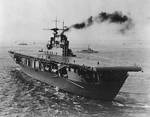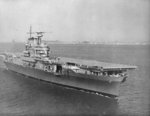Hornet (Yorktown-class)
| Country | United States |
| Ship Class | Yorktown-class Aircraft Carrier |
| Builder | Newport News Shipbuilding |
| Laid Down | 25 Sep 1939 |
| Launched | 14 Dec 1940 |
| Commissioned | 20 Oct 1941 |
| Sunk | 27 Oct 1942 |
| Displacement | 19,900 tons standard; 25,600 tons full |
| Length | 761 feet |
| Beam | 83 feet |
| Draft | 28 feet |
| Machinery | 9 boilers, steam turbines, 4 shafts |
| Power Output | 120,000 shaft horsepower |
| Speed | 32 knots |
| Range | 12,500nm at 15 knots |
| Crew | 2,919 |
| Armament | 9x5-in, 4x quad 1.1-in machine guns, 24 0.50cal machine guns |
| Armor | 2.5 to 4-in belt, 4-in bulkheads, 2 to 4-in conning tower, 4-in steering gear |
| Elevators | 3 |
| Catapults | 3 |
| Aircraft | 90 |
Contributor: C. Peter Chen
ww2dbaseThe fleet carrier Hornet was commissioned less than a month and half before the United States was drawn into WW2 with the strike on Pearl Harbor. After her shakedown cruise in the Atlantic Ocean, her first mission was to carry and launch the 16 B-25 bombers piloted by James Doolittle's raiders in Mar-Apr 1942. After a short time in South Pacific, she was recalled to Pearl Harbor, then participated in the Battle of Midway in Jun 1942. Her aircraft's battle record against the Japanese aircraft carriers was sub par, but though they redeemed themselves by sinking the heavy cruiser Mikuma. She then participated in the Solomons Campaign. In the latter campaign, during the Battle of Santa Cruz (25-28 Oct 1942), Enterprise's aircraft damaged the carrier Zuiho while Hornet's aircraft damaged carrier Shokaku and cruiser Chikuma. While her aircraft delivered their deadly cargo on the Japanese fleet, she was struck by a Japanese counterstrike. Heavily damaged by bombs and torpedoes, Rear Admiral George Murray transferred his flag from Hornet to cruiser Pensacola. In the early afternoon of 26 Oct, Captain Mason ordered all wounded and non-essential men to be removed from the ship. Kondo put together a smaller aerial strike force than the morning attack to spearhead a second assault that included surface ships. At 1515, the Japanese aircraft reached Hornet, launching six torpedoes. Northampton cut the towing cables and successfully maneuvered to save herself, but the immobile Hornet was struck by one of them, rapidly flooding the after engine room. At 1540 Japanese dive bombers appeared, but all their bombs missed. At 1550, a formation of six horizontal bombers appeared and scored a hit on Hornet's flight deck. At 1702, a small strike force from light carrier Junyo scored a final bomb hit on the carrier's hangar deck. After suffering 111 killed and 108 wounded, she was finally to be scuttled. American destroyer Mustin received the order to launch eight torpedoes at Hornet, and to a great embarrassment, only three hit, and they did not effectively sink the carrier. At 1920, destroyer Anderson fired eight torpedoes as well. Only six of them hit, and Hornet again failed to be sunk. The American ships resorted to using gunfire. After 300 rounds, they failed once again. Hornet finally sank at 0130 on 27 Oct after the arrival of Kondo's fleet at the face of four Japanese 24-inch torpedoes launched from destroyers Makigumo and Akigumo.
ww2dbaseAn exchange between a pair Hornet survivors supposedly went something like this:
ww2dbase"Are you going to re-enlist?"
ww2dbase"Goddammit, yes! On the new Hornet!"
ww2dbaseSources: Naval Historical Center, the Struggle for Guadalcanal.
Last Major Revision: Mar 2006
Aircraft Carrier Hornet (Yorktown-class) Interactive Map
Photographs
 |  |
Hornet (Yorktown-class) Operational Timeline
| 20 Oct 1941 | Hornet (Yorktown-class) was commissioned into service. |
| 11 Mar 1942 | USS Hornet (Yorktown-class), USS Nashville, and their escorts transited the Panama Canal and entered the Pacific Ocean. |
| 20 Mar 1942 | USS Hornet arrived at San Francisco, California, United States. |
| 2 Apr 1942 | USS Hornet departed Naval Air Station Alameda near San Francisco, California with James Doolittle and his 16 US Army B-25 bombers on board. |
| 13 Apr 1942 | Task Force 16 (USS Enterprise) made rendezvous with Task Force 18 (USS Hornet) north of Midway and pressed on westward toward the launch point for the Doolittle Raid. Later on the same day, they crossed the 180th meridian. |
| 18 Apr 1942 | 16 US Army Air Force B-25 bombers launched from USS Hornet attacked Tokyo, Yokohama, Yokosuka, Kobe, Osaka, Nagoya, and other targets in the Japanese home islands at about 1200 hours. Most of the bombers would fly on to crash land in or bail out over China, while one landed in Russia and the crew were interned by the Soviets, who had a non-aggression treaty in place with Japan. |
| 25 Apr 1942 | USS Hornet arrived at Pearl Harbor after conducting the Doolittle Raid. |
| 30 Apr 1942 | USS Hornet sailed toward Coral Sea, but would arrive too late to participate in the upcoming battle. |
| 11 May 1942 | USS Hornet arrived near New Hebrides. |
| 16 May 1942 | USS Hornet received orders to return to Pearl Harbor. |
| 26 May 1942 | USS Hornet arrived at Pearl Harbor, US Territory of Hawaii. |
| 28 May 1942 | USS Hornet departed Pearl Harbor, US Territory of Hawaii for Midway Atoll. |
| 2 Jun 1942 | USS Hornet made rendezvous with USS Yorktown and USS Enterprise 350 miles northeast of Midway. Rear Admiral Fletcher took overall tactical command of this fleet. |
| 13 Jun 1942 | USS Hornet arrived at Pearl Harbor. |
| 9 Aug 1942 | USS Hornet patrolled waters near US Territory of Hawaii. |
| 17 Aug 1942 | USS Hornet and Task Force 17 departed Pearl Harbor, US Territory of Hawaii for the South Pacific. |
| 29 Aug 1942 | USS Hornet arrived in the South Pacific, replacing damaged USS Enterprise. |
| 5 Oct 1942 | Task Force 17 (USS Hornet, Northampton, Pensacola, Juneau, San Diego, 3 destroyers) struck Japanese installations around the southern end of Bougainville in the Solomon Islands (Buin-Faisi-Tonolai Raid). |
| 26 Oct 1942 | At the Battle of Santa Cruz Islands, US forces achieved victory but saw USS Enterprise, USS South Dakota, and USS San Juan damaged. Aircraft carrier USS Hornet (Yorktown-class) was badly damaged from aerial bombs and torpedoes and then finally hit by three Type 93 torpedoes launched from Japanese destroyers Akigumo and Makigumo which caused her to sink 30 minutes later. On the Japanese side, carriers Shokaku and Zuiho were damaged by dive bombers from USS Hornet and USS Enterprise, respectively. |
| 27 Oct 1942 | USS Hornet (Yorktown-class) was lost during the naval Battle of Santa Cruz. |
Please consider supporting us on Patreon. Even $1 per month will go a long way! Thank you. Please help us spread the word: Stay updated with WW2DB: |
Visitor Submitted Comments
5 Nov 2010 07:55:42 PM
Dear Anonymus
My wifes grandfather served on the Hornet when it was sunk also. Please e-mail me we may have some memorabilia that you may want or we could get you copies of it. His name was Lester A Van Rooy he was an officer we believe.
18 Nov 2010 11:53:45 AM
Technicly not a Yorktown, was built as HORNET Class.
23 Nov 2010 09:03:27 PM
My dad survived the sinking, and then meet my mother in Nouema. He served 36 years in the Navy.
15 Jan 2011 03:25:20 PM
My uncle Joseph F Kirwin of Newport RI was a pilot aboard the Hornet and we have heard stories of his heroism during the sinking. Any information about him would be of great interest to me. Uncle Joe died in 1998.
3 Jun 2011 03:48:02 PM
My cousin, Nolen Moore was one of the
survivors of the Hornet. I would love to
receive any information possible. God bless
all of you.
18 Sep 2012 05:17:42 PM
Seeking any info about Jimmy L. George, from Wichita, Kansas, (mother, Leona George-Pryor, also of Wichita) killed on the U.S.S. Hornett.
Thank you.
28 May 2014 07:23:45 AM
My Great Uncle Hubert Barbour was lost at sea on the Hornet and I would love to have any kind of information possible about the ship and him.
Thank You
4 Dec 2014 10:10:13 AM
Oscar Stephen Lovering, AM 3/c,was a very close friend of my mother. He last wrote her on Oct. 16,1942. I just came across his picture and letters sent to my mother. I would like to know more about him, if that is possible.
2 Feb 2015 06:23:44 PM
Grandfather Roy Dale Clayton "Red" survived the hornet sinking..I'm 19..never got to meet him he drank himself to death and my dad..his son died when I was in 6th grade of the same thing..would be nice to know if someone remebers Roy. Like to know more about him. Have a lot of his old military records and medals..
23 Mar 2020 12:09:46 PM
My grandfather, Elton C. Snider, served on the Hornet during Midway. Interested to hear from anyone that may have info and/or photos of him during then. Thanks.
All visitor submitted comments are opinions of those making the submissions and do not reflect views of WW2DB.

» Mitscher, Marc
» Ring, Stanhope
Event(s) Participated:
» Doolittle Raid
» Battle of Midway and the Aleutian Islands
» Solomon Islands Campaign
Document(s):
» US Aircraft Carrier Functions
» US Aircraft Carrier Operational Status By Month
» US Carrier Time Operational
Related Books:
» Santa Cruz 1942: Carrier duel in the South Pacific
 |  |
- » 1,172 biographies
- » 337 events
- » 44,911 timeline entries
- » 1,245 ships
- » 350 aircraft models
- » 207 vehicle models
- » 376 weapon models
- » 123 historical documents
- » 261 facilities
- » 470 book reviews
- » 28,524 photos
- » 365 maps
Thomas Dodd, late 1945
18 Mar 2010 06:48:31 PM
My Uncle Leonard (Chick)Chicoine served on the carrier Hornet and survived the sinking of the vessel at the battle of Vera Cruz. He will be celebrating his 100th birthday on April 24. He may be one of the oldest survivors of those who served on the ship as he was 32 when it sank. He was the band director and served as a stretcher bearer during battle conditions.
Is there any survivors association or system in place to celebrate the birthdays of these elderly sailors who served in WWII? We are preparing a memory book for his birthday and would appreciate any commerative material that could be provided for the celebration.